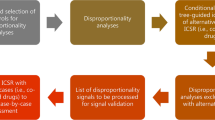Abstract
The US Food and Drug Administration (FDA) recently published a warning regarding pancreatitis in association with the use of exenatide, an incretin mimetic used for the treatment of patients with diabetes mellitus. We note that this safety issue is not associated with a signal of disproportionate reporting (SDR) in the FDA Adverse Event Reporting System (AERS) database or the World Health Organization (Uppsala Monitoring Centre) Vigibase for any of four data-mining algorithms we tested (proportional reporting ratio, the multi-item gamma-Poisson shrinker, an urn model and the Bayesian Confidence Propagation Neural Network). Exenatide and acute pancreatitis may thus represent a ‘false-negative’ result for disproportionality-based data-mining methodology generally. We evaluate the possibility that this lack of an SDR is caused by the phenomenon known as ‘masking’ (or ‘cloaking’) and reject this hypothesis. While positive findings are understandably more exciting, we discuss why publishing negative findings, such as in this example, is important for placing the capabilities and limitations of drug safety data mining into proper perspective.


Similar content being viewed by others
References
Gould AL. Practical pharmacovigilance strategies. Pharmacoepidemiol Drug Saf 2003; 12: 559–74
Hauben M, Madigan D, Gerrits C, et al. The role of data mining in pharmacovigilance. Expert Opin Drug Saf 2005; 4 (5): 929–48
Amori RE, Lau J, Pittas AG. Efficacy and safety of incretin therapy in type 2 diabetes: systematic review and meta-analysis. JAMA 2007 Jul 11; 298 (2): 194–206
US Food and Drug Administration. Exenatide (marketed as Byetta) information [online]. Available from URL: http://www.fda.gov/cder/drug/infopage/exenatide/default.htm [Accessed 2007 Nov 2]
Hauben M, Reich L. Communication of findings in pharmacovigilance: use of the term “signal” and the need for precision in its use. Eur J Clin Pharmacol 2005 Jul; 61 (5–6): 479–80
Hochberg AM, Reisinger SJ, Pearson RK, et al. Using data mining to predict safety actions from FDA Adverse Event Reporting System data. Drug Inf J 2007; 41 (5): 633–43
Hauben M, Reich L. Drug-induced pancreatitis: lessons in data mining. Br J Clin Pharmacol 2004; 58 (5): 560–2
Begaud B, Moride Y, Tubdert-Bitter P, et al. False positives in spontaneous reporting: should we worry about them? Br J Clin Pharmacol 1994; 38: 401–4
Sammett D, Greben C, Sayeed-Shah U. Acute pancreatitis caused by penicillin. Dig Dis Sci 1998; 43 (8): 1778–83
Hauben M. Application of an empirical Bayesian data mining algorithm to reports of pancreatitis associated with atypical antipsychotics. Pharmacotherapy 2004; 24 (9): 1122–9
US Food and Drug Administration. Guidance for industry: providing regulatory submissions in electronic format — content of labelling [online]. Available from http://www.fda.gov/cder/guidance/6719fnl.htm [Accessed 2007 Oct 31]
US Food and Drug Administration. Updated safety information: warnings regarding serious rash, including Stevens-Johnson Syndrome and hypersensitivity reactions, and psychiatric symptoms [online]. Available from URL: http://www.fda.gov/Medwatch/SAFETY/2007/Provigil_dhcpletter091207_final.pdf [Accessed 2007 Nov 2]
US Food and Drug Administration. CellCept (mycophenolate mofetil) [online]. Available from URL: http://www.fda.gov/Medwatch/SAFETY/2007/safety07.htm#CellCept2 [Accessed 2007 Nov 2]
US Food and Drug Administration. Viagra (sildenafil), Cial11. US Food and Drug Administration. Guidance for industry: providing regulatory is (tadalafil), Levitra (vardenafil), Revatio (sildenafil) [online]. Available from URL: http://www.fda.gov/Medwatch/SAFETY/2007/safety07.htm#PDE5 [Accessed 2007 Nov 2]
Almenoff JS, DuMouchel W, Kindman LA, et al. Disproportionality analysis using empirical Bayes data mining: a tool for the evaluation of drug interactions in the post-marketing setting [erratum in Pharmacoepidemiol Drug Saf 2004; 13: 111]. Pharmacoepidemiol Drug Saf 2003; 12 (6): 517–21
Levine JG, Tonning JM, Szarfman A. Erratum: reply. The evaluation of data mining methods for the simultaneous and systematic detection of safety signals in large databases: lessons to be learned. Br J Clin Pharmacol 2007; 64 (1): 118
Acknowledgements
Manfred Hauben and Alan Hochberg are both responsible for the design and conduct of this study; collection, management, analysis and interpretation of the data; and preparation, review and approval of the manuscript. We thank Steph Reisinger for comments on the manuscript, and we thank the reviewers for further constructive questions and comments.
Alan Hochberg is an employee of ProSanos Corporation, a vendor of drug-safety data-mining software and services related to methodology discussed in this paper. Manfred Hauben is an employee of Pfizer Inc., a company that manufacturers and markets drugs in the same therapeutic class as exenatide.
Manfred Hauben discloses that he owns stock options and/or stock in Pfizer and other pharmaceutical companies that may manufacture drugs in the same class as those discussed in this article.
No specific funding was received for the conduct of this study or the preparation of this paper.
Author information
Authors and Affiliations
Corresponding author
Rights and permissions
About this article
Cite this article
Hauben, M., Hochberg, A. The Importance of Reporting Negative Findings in Data Mining. Pharm Med 22, 215–219 (2008). https://doi.org/10.1007/BF03256706
Published:
Issue Date:
DOI: https://doi.org/10.1007/BF03256706




